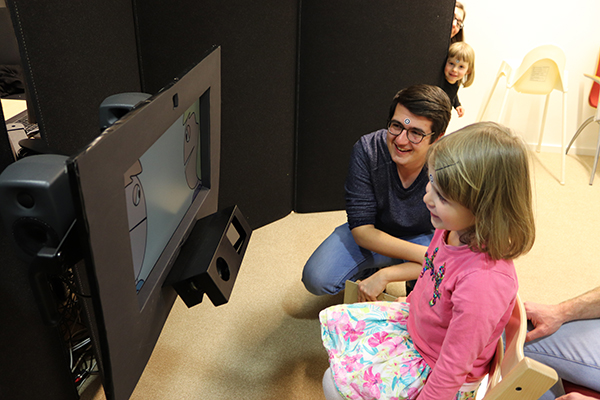MPI labs
Researchers and students at the MPI have access to a wide range of facilities and labs for conducting their research, all on-site at the MPI. For more information about the specific labs and how they are used, click on the relevant section below.
-
Motion Capture lab
-
At the MPI, our state-of-the-art Motion Capture Lab allows researchers to explore how humans use their hands, faces, and gestures, to communicate. Equipped with 14 Valkyrie and 4 Vero cameras by Vicon, our system captures body, face and hand movement with exceptional precision. This enables detailed analysis of gesture, sign language, and other visual forms of communication across cultures and languages. We render these movements as lifelike digital avatars, allowing for controlled experimentation in virtual reality settings. This technology advances research in language processing, multimodal communication, and even the development of AI-driven virtual agents.
-
Virtual reality lab
-
At the MPI we have a state-of-the-art immersive Virtual Reality (VR) laboratory. Traditionally, psycholinguistic experiments placed participants in an impoverished environment, where they interacted with single words or sentences on a computer screen. However, language in the real world is more than words. Listeners rely on cues from their physical and social environments to make sense of what they hear. Speakers mobilise their bodies and physical objects in concert with their linguistic resources to communicate their thoughts. In the virtual realm, we can simulate some of this rich context to study how language processing is shaped by our interactions with the physical and social world.
- Baby Lab
-
Researchers at our Language Development Department are, as the name suggests, interested in understanding how children learn a language. To conduct their studies, our research teams use both the Baby Labs at the Baby and Child Research Center, located elsewhere on the Radboud University campus, as well as our own baby labs on the MPI site.
-
Behavioural labs (sound-proof rooms)
-
Here at the MPI we have six behavioral labs, all with sound-proof booths. Each booth is equipped with a button box, a monitor, a microphone, a pair of headphones, and a keyboard.
Since there are multiple sound-proof booths installed in the same room, it is possible to link them and conduct interactive experiments or make high-fidelity recordings of conversations.
The set-up of these labs is especially flexible thanks to the use of small DJ mixers. This means that researchers can record stimuli and responses on various devices. In conjunction with the PRESENTATION sound-recording feature, researchers can analyse vocal responses offline using semi-automatic PRAAT scripts, replacing the notoriously unreliable voicekey.
-
EEG lab
-
At the MPI we have two EEG labs. Our researchers also have access to additional EEG labs at the Donders Institute, Centre for Cognitive Neuroimaging.
The main features of our labs include:
- Four combinable 32-channel BrainAmps DC amplifiers, ActiCap active electrode systems with EasyCap-manufactured, MPI-custom 36-, 64- and 128-electrode montages, as well as ActiCap standard 10-20 montages, an additional biosignal amplifier (BP ExG), and Brain Vision Recorder software
- Fully shielded sound-proof experiment rooms with climate-control, an adjustable colour-mixture lighting system, and high-quality video monitoring and recording of the participant
- Brain Vision Analyser for standard ERP analysis, FieldTrip for more advanced analyses (e.g., time-frequency, coherence, and statistical cluster randomisation tests)
- Stimuli presented with Presentation coupled to high-quality audio and video display equipment
- Eye-tracking facilities (EyeLink 1000) for simultaneous EEG and eye movement recording
-
Eye-tracking labs
-
Our researchers have access to three experimental rooms with eye-tracking equipment. Two of these eye-trackers are head-mounted. Two portable eye-trackers are also available for field studies, one of which can also be used with children.
-
Gesture lab
-
photos with permission from corpus NGT, under Creative Commons license In this lab, we use multiple digital video cameras (including two top views) to conduct research into gestures and sign language.
In such studies participants are filmed whilst they complete different tasks, such as watching films or narrating them to someone else using both speech and gestures or using only their hands (i.e. pantomimes), playing computer games with a co-participant on a screen, looking at pictures and naming them, or having conversations with a few other participants.
Sometimes participants may also be asked to wear gesture gloves so that our researchers can track the motion of their hands or eye-tracker devices.
- Molecular biology lab
-
In January 2015, the Institute celebrated the opening of its own state-of-the-art wet-lab facilities for molecular biology. These facilities, located in the new wing, are used by the Language and Genetics Department as well as the Neurogenetics of Vocal Communication research group. The laboratory area consists of 250m2 of laboratory space and features dedicated laboratories for general molecular biology (DNA extraction, processing and analysis), RNA work, histology, microscopy, and tissue culture, used for growing human neurons and brain organoids.
To support the researchers in their work, the laboratories are equipped with a broad range of equipment, for example, Tecan microplate readers that are able to measure fluorescence and luminescence in living cells and a Zeiss confocal microscope used to image macromolecules and neural networks and their activity.






Share this page